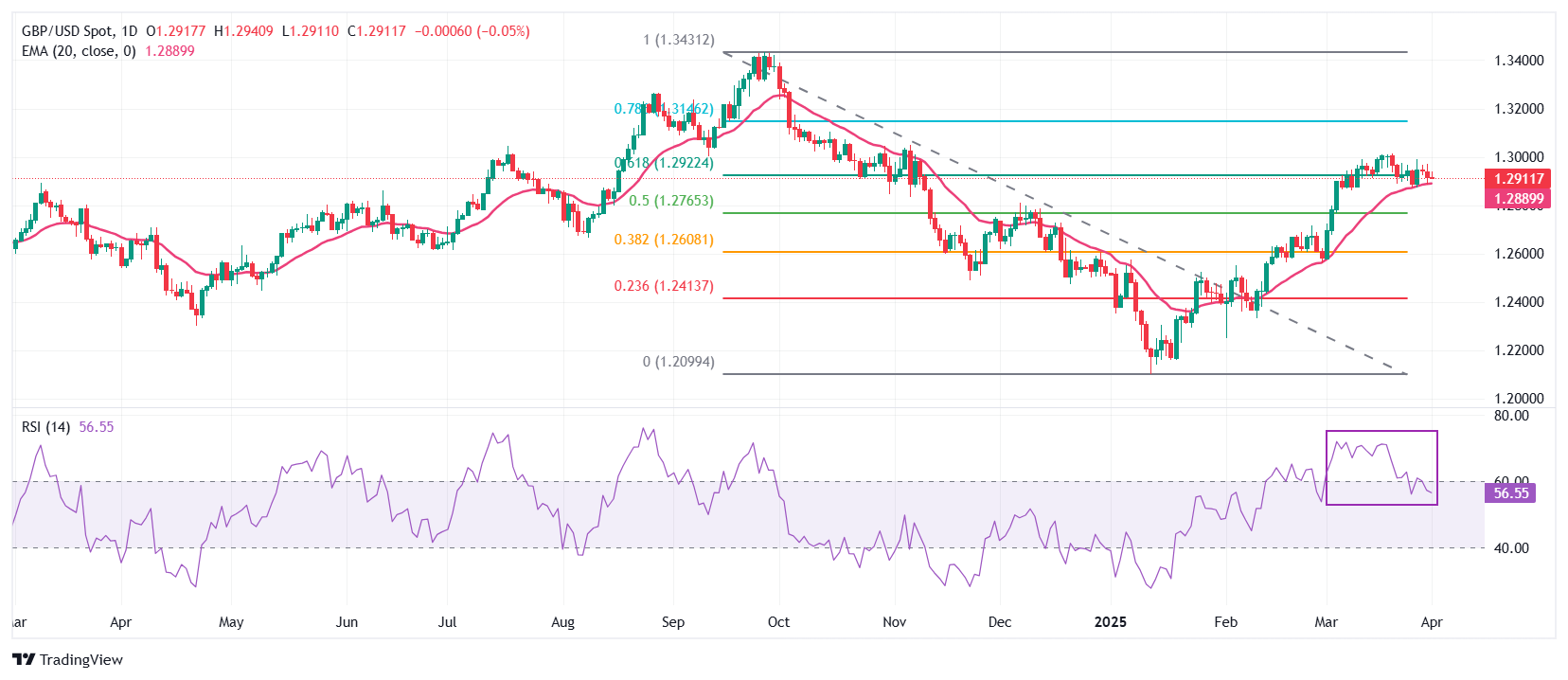- The Pound Sterling trades sideways against the US Dollar around 1.2900 as investors await the release of US President Trump’s reciprocal tariffs.
- Retaliatory tariffs from US trading allies could result in a global trade war.
- The UK fiscal watchdog projects a 1% cut in the size of the economy due to potential risks of Trump’s tariffs.
The Pound Sterling (GBP) ranges around 1.2900 against the US Dollar (USD) in Tuesday’s European session. The GBP/USD pair flattens as investors brace for reciprocal tariffs from United States (US) President Donald Trump, which will be announced on the so-called “Liberation Day” on Wednesday.
President Trump is expected to impose large tariffs on nations with significantly higher trade surpluses against the US, aiming to fix what he calls “trade imbalances”.
On Monday, US Treasury Secretary Scott Bessent said in an interview with Fox News that people are going to see “fair trade” that will make the global trading system “fair for American workers” again, and that the US trading allies will have an opportunity to lower their “tariffs and non-tariff barriers”.
Given that higher tariffs from Donald Trump are inevitable, investors will majorly focus on responses from US trading partners. Trump’s tariffs are expected to majorly impact China, the Eurozone, Canada, Japan, and Mexico, and any retaliatory measures from them will lead to an all-over global trade war. Such a scenario will be unfavorable for global economic growth, including the US, as US importers will bear the impact of higher tariffs.
This week, investors will also focus on a slew of US business and labor market data, which will influence market expectations for the Federal Reserve’s (Fed) monetary policy outlook. Meanwhile, Fed officials have been guiding that interest rates should remain in their current range of 4.25%-4.50% as Trump’s economic policies are expected to be inflationary for the economy.
In Tuesday’s session, investors will focus on the US S&P Global and ISM Manufacturing Purchasing Managers Index (PMI) data for March, which will be published at 13:45 and 14:00 GMT, respectively. The revised S&P Global Manufacturing PMI is expected to remain unchanged from the preliminary reading of 49.8 in March, while the ISM Manufacturing PMI is estimated to have fallen to 49.5 from 50.3 in February. A figure below 50.0 suggests that the manufacturing sector activity contracted.
Daily digest market movers: Pound Sterling trades with caution as US-UK economic deal delays
- The Pound Sterling trades cautiously against its major peers on Tuesday, with United Kingdom (UK) officials assessing potential economic risks from Trump’s tariffs, which will be unveiled on Wednesday.
- On Monday, UK Prime Minister Keir Starmer’s spokesman said that the administration has been actively preparing for all “eventualities” ahead of President Trump’s announcement of “planned tariffs”, which are expected to impact the “UK alongside other countries”. Starmer added that negotiations between London and Washington on securing an economic deal that would have averted tariffs have been extended beyond Wednesday.
- The UK Office for Business Responsibility (OBR) warns that Trump’s policies could wipe out the government fiscal buffer and cut the economy’s size by as much as 1%. Such a scenario could force the Bank of England (BoE) to adopt a swift monetary easing stance to stimulate economic growth. Currently, traders see the BoE reducing interest rates two times this year. The BoE has already cut interest rates once in 2025.
- On the economic front, investors will focus on revised S&P Global/CIPS Manufacturing PMI data for March, which will be published at 08:30 GMT. The Manufacturing PMI is expected to have remained in line with preliminary estimates of 44.6.
Technical Analysis: Pound Sterling ranges against US Dollar around 1.2900

The Pound Sterling trades inside Monday’s trading range against the US Dollar on Tuesday. The GBP/USD pair continues to wobble around the 61.8% Fibonacci retracement, plotted from late-September high to mid-January low, near 1.2930. The 20-day Exponential Moving Average (EMA) continues to provide support to the pair around 1.2890.
The 14-day Relative Strength Index (RSI) cools down to near 60.00 after turning overbought above 70.00. Should a fresh bullish momentum come into action if the RSI resumes the upside journey after holding above the 60.00 level
Looking down, the 50% Fibonacci retracement at 1.2770 and the 38.2% Fibonacci retracement at 1.2615 will act as key support zones for the pair. On the upside, the October 15 high of 1.3100 will act as a key resistance zone.
Pound Sterling FAQs
The Pound Sterling (GBP) is the oldest currency in the world (886 AD) and the official currency of the United Kingdom. It is the fourth most traded unit for foreign exchange (FX) in the world, accounting for 12% of all transactions, averaging $630 billion a day, according to 2022 data. Its key trading pairs are GBP/USD, also known as ‘Cable’, which accounts for 11% of FX, GBP/JPY, or the ‘Dragon’ as it is known by traders (3%), and EUR/GBP (2%). The Pound Sterling is issued by the Bank of England (BoE).
The single most important factor influencing the value of the Pound Sterling is monetary policy decided by the Bank of England. The BoE bases its decisions on whether it has achieved its primary goal of “price stability” – a steady inflation rate of around 2%. Its primary tool for achieving this is the adjustment of interest rates. When inflation is too high, the BoE will try to rein it in by raising interest rates, making it more expensive for people and businesses to access credit. This is generally positive for GBP, as higher interest rates make the UK a more attractive place for global investors to park their money. When inflation falls too low it is a sign economic growth is slowing. In this scenario, the BoE will consider lowering interest rates to cheapen credit so businesses will borrow more to invest in growth-generating projects.
Data releases gauge the health of the economy and can impact the value of the Pound Sterling. Indicators such as GDP, Manufacturing and Services PMIs, and employment can all influence the direction of the GBP. A strong economy is good for Sterling. Not only does it attract more foreign investment but it may encourage the BoE to put up interest rates, which will directly strengthen GBP. Otherwise, if economic data is weak, the Pound Sterling is likely to fall.
Another significant data release for the Pound Sterling is the Trade Balance. This indicator measures the difference between what a country earns from its exports and what it spends on imports over a given period. If a country produces highly sought-after exports, its currency will benefit purely from the extra demand created from foreign buyers seeking to purchase these goods. Therefore, a positive net Trade Balance strengthens a currency and vice versa for a negative balance.

